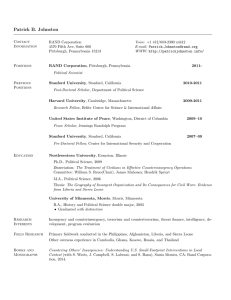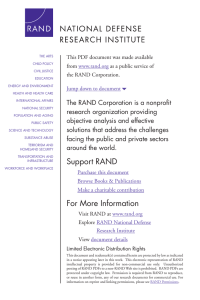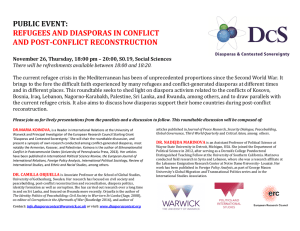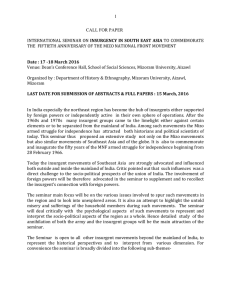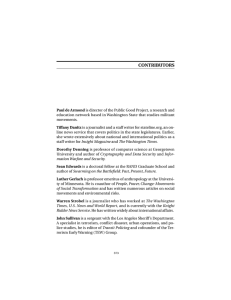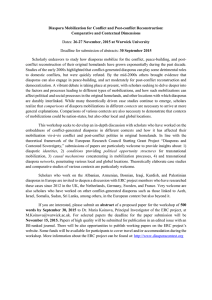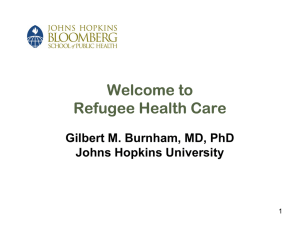Research Brief The New Face of Insurgency
advertisement
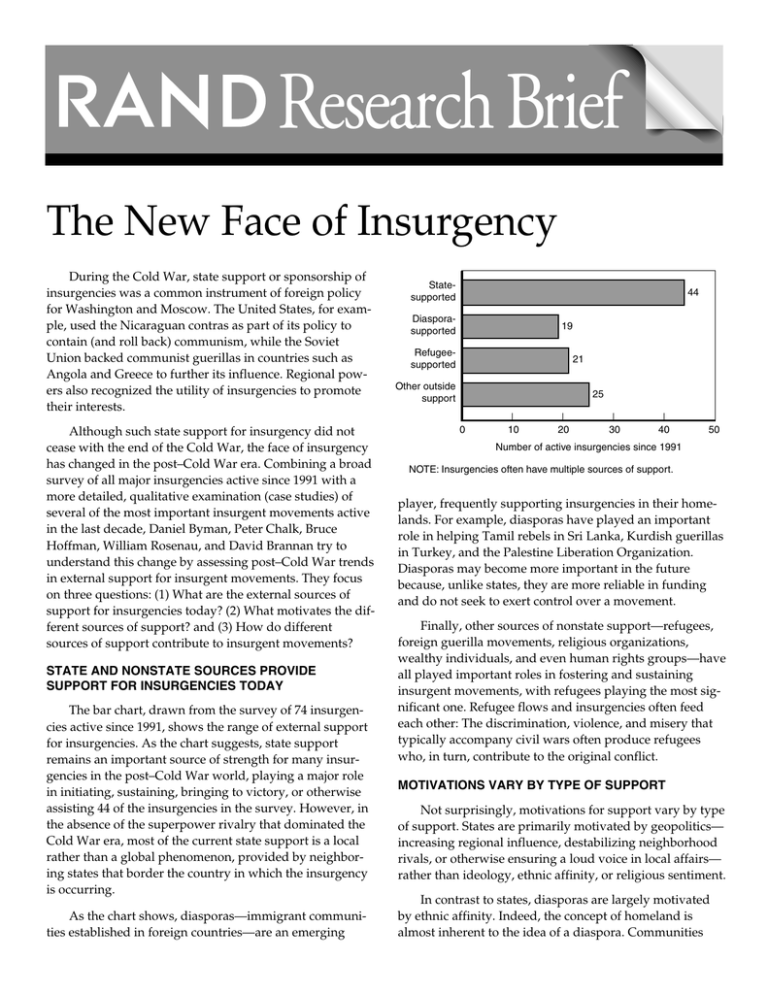
Research Brief The New Face of Insurgency During the Cold War, state support or sponsorship of insurgencies was a common instrument of foreign policy for Washington and Moscow. The United States, for example, used the Nicaraguan contras as part of its policy to contain (and roll back) communism, while the Soviet Union backed communist guerillas in countries such as Angola and Greece to further its influence. Regional powers also recognized the utility of insurgencies to promote their interests. Although such state support for insurgency did not cease with the end of the Cold War, the face of insurgency has changed in the post–Cold War era. Combining a broad survey of all major insurgencies active since 1991 with a more detailed, qualitative examination (case studies) of several of the most important insurgent movements active in the last decade, Daniel Byman, Peter Chalk, Bruce Hoffman, William Rosenau, and David Brannan try to understand this change by assessing post–Cold War trends in external support for insurgent movements. They focus on three questions: (1) What are the external sources of support for insurgencies today? (2) What motivates the different sources of support? and (3) How do different sources of support contribute to insurgent movements? STATE AND NONSTATE SOURCES PROVIDE SUPPORT FOR INSURGENCIES TODAY The bar chart, drawn from the survey of 74 insurgencies active since 1991, shows the range of external support for insurgencies. As the chart suggests, state support remains an important source of strength for many insurgencies in the post–Cold War world, playing a major role in initiating, sustaining, bringing to victory, or otherwise assisting 44 of the insurgencies in the survey. However, in the absence of the superpower rivalry that dominated the Cold War era, most of the current state support is a local rather than a global phenomenon, provided by neighboring states that border the country in which the insurgency is occurring. As the chart shows, diasporas—immigrant communities established in foreign countries—are an emerging Statesupported 44 Diasporasupported 19 Refugeesupported 21 Other outside support 25 0 10 20 30 40 50 Number of active insurgencies since 1991 NOTE: Insurgencies often have multiple sources of support. player, frequently supporting insurgencies in their homelands. For example, diasporas have played an important role in helping Tamil rebels in Sri Lanka, Kurdish guerillas in Turkey, and the Palestine Liberation Organization. Diasporas may become more important in the future because, unlike states, they are more reliable in funding and do not seek to exert control over a movement. Finally, other sources of nonstate support—refugees, foreign guerilla movements, religious organizations, wealthy individuals, and even human rights groups—have all played important roles in fostering and sustaining insurgent movements, with refugees playing the most significant one. Refugee flows and insurgencies often feed each other: The discrimination, violence, and misery that typically accompany civil wars often produce refugees who, in turn, contribute to the original conflict. MOTIVATIONS VARY BY TYPE OF SUPPORT Not surprisingly, motivations for support vary by type of support. States are primarily motivated by geopolitics— increasing regional influence, destabilizing neighborhood rivals, or otherwise ensuring a loud voice in local affairs— rather than ideology, ethnic affinity, or religious sentiment. In contrast to states, diasporas are largely motivated by ethnic affinity. Indeed, the concept of homeland is almost inherent to the idea of a diaspora. Communities abroad often feel a genuine sympathy or guilt for the struggles of their brethren elsewhere, and insurgencies actively play on this sympathy and guilt to secure support, occasionally relying on coercion when support is not voluntarily offered. Refugees are generally motivated by a powerful desire to regain their homeland or to restore their nation’s influence over a part of a territory. Refugees may also back insurgents for protection from predatory governments in their host country, from rival groups, or from bandit forces. When rebel movements control refugee camps, coercion can often explain why refugees proffer their support. STATES PROVIDE KEY FORMS OF SUPPORT; NONSTATE FORMS ARE ALSO IMPORTANT To be successful, insurgent movements have a variety of requirements. These include material requirements, such as money, safe havens, and arms, and human requirements, such as training, intelligence, and direct military support (e.g., foreign forces). The figure below illustrates the types of assistance given by various supporters. States are clearly the significant contributors, often providing fighters with arms, money, and material, as well as providing a safe place to organize and train. States also provide various types of diplomatic assistance, including helping insurgents represent their cause in international fora and with major powers. Form of Support States Diasporas Refugees Other Non-state Money Safe Haven Diplomatic Backing Arms Training Intelligence Direct Mil Support Inspiration Significant contribution Limited contribution Minor contribution However, nonstate forms of support are also important. Financial assistance is far and away the most common form of assistance diasporas provide, but some diasporas have also provided diplomatic support. Members of the Tamil diaspora have acted as de facto political representatives of the Tamil Tigers. Finally, Hezbollah has used the Lebanese Shi’a diaspora to gather intelligence abroad, including information that has helped Hezbollah conduct terrorist attacks on Israeli targets overseas. Poor and lacking even basic resources, refugees can seldom offer arms or money, but they can provide safe havens and direct military support (e.g., manpower), especially in the aftermath of mass refugee waves. Although the Taliban relied on Pakistan for arms, material, and other basic support, it was formed among displaced Afghans, particularly those who had enrolled as seminary students in Pakistan. Beyond refugees, other nonstate supporters have sometimes increased an insurgency’s military power, financial position, or diplomatic influence. However, overall, such supporters have not had the same impact on insurgencies as states, diasporas, and refugees. IMPLICATIONS FOR ANALYSTS The end of the Cold War has fundamentally changed the role external actors play in insurgent conflicts. Understanding insurgent struggles today requires recognizing the changing agendas and limited means of state sponsors, the possible increase in the role of diasporas, and the rise of other nonstate backers. This recognition includes understanding that not all outside actors are equally important—that their impact varies according to the needs of the insurgent movement and the context of its struggle. It requires understanding that the traditional, country-based focus in assessing insurgencies is no longer valid, given, for example, that Hezbollah works with Lebanese Shi’a in the triple border area of Argentina, Paraguay, and Brazil. And finally, it requires understanding the importance of passive support—that besides tracking the flow of arms, money, volunteers, and other active forms of support, analysts must also look at what is not done in host countries that allows diasporas and other interested outsiders to operate freely. RAND research briefs summarize research that has been more fully documented elsewhere. This research brief describes work done for the National Security Research Division; it is documented in Trends in Outside Support for Insurgent Movements by Daniel L. Byman et al., MR-1405OTI, 2001, 138 pp., $16.00, ISBN: 0-8330-3052-3, available from RAND Distribution Services (Telephone: 310-451-7002; toll free 877-584-8642; FAX: 310-451-6915; or email: order@rand.org). Abstracts of RAND documents may be viewed at www.rand.org. Publications are distributed to the trade by NBN. RAND® is a registered trademark. RAND is a nonprofit institution that helps improve policy and decisionmaking through research and analysis; its publications do not necessarily reflect the opinions or policies of its research sponsors. R 1700 Main Street, P.O. Box 2138, Santa Monica, California 90407-2138 • Telephone 310-393-0411 • FAX 310-393-4818 1200 South Hayes Street, Arlington, Virginia 22202-5050 • Telephone 703-413-1100 • FAX 703-413-8111 201 North Craig Street, Suite 102, Pittsburgh, Pennsylvania 15213-1516 • Telephone 412-683-2300 • FAX 412-683-2800 RB-7409-OTI (2001)

